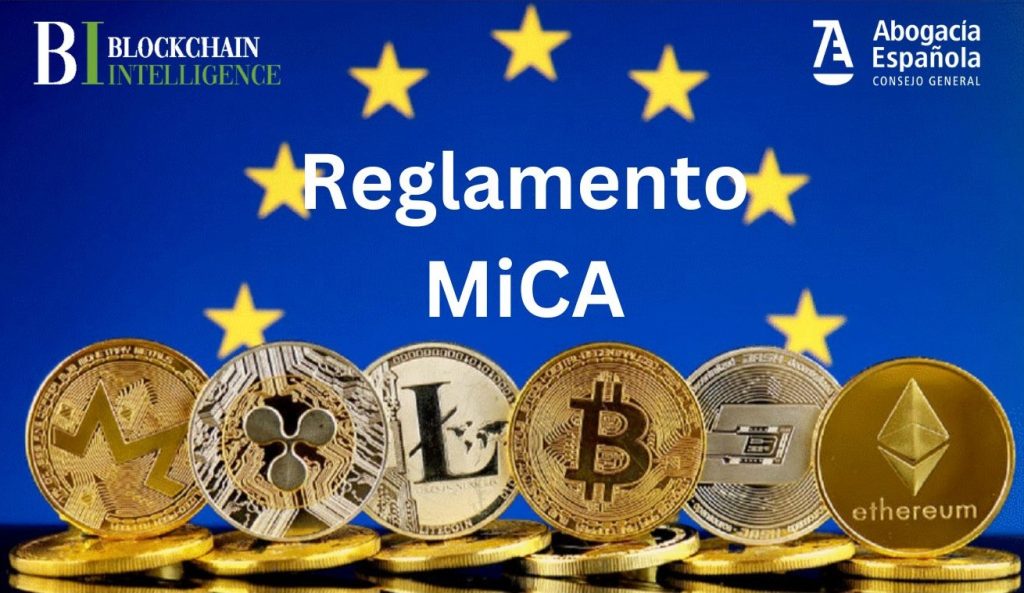
Approval of the Markets in Cryptoassets (MiCA) Regulation
The European Markets in Cryptoassets (MiCA) Regulation is approved. The need for legal advice for a rising market is growing.
Almudena de la Mata, Managing Partner of Blockchain Intelligence
President Blockchain Law & Compliance Institute
Corresponding academic of the Royal Academy of Jurisprudence and Legislation.
20 April 2023

The European Parliament has approved today the Markets in Cryptoassets (MiCA) Regulation, providing legal certainty to a key market for the digital economy, web 3.0 and metaverses.
The need for legal advice is triggered in a matter that affects both the field of financial investment and business operations and means of payment. Private and institutional investors, as well as crypto asset issuers and service providers, need legal and compliance support on the matter. The General Council of the Spanish Lawyers and Blockchain Intelligence have spent years contributing to the regulatory development and developing training and knowledge to train lawyers and contribute to greater legal security of this new social operation.
The European Parliament has approved today the Markets in Cryptoassets (MiCA) Regulation after three years of intense negotiation. It defines the European regulatory framework applicable to digital asset markets as well as to crypto asset issuers and service providers. The objectives of the standard are clear. The intention is also evident to prevent phenomena such as the issuance of stablecoins or Asset Reference Tokens (cryptocurrencies referenced to FIAT currencies issued by central banks) from affecting the control of monetary policy. These objectives reflect the values present in the European regulation and are comparable to the regulations, for example, of financial instruments.
The phenomena that have occurred in the crypto-asset markets in recent years have further highlighted the need to impose basic principles on the issuance and trading of these technology-based assets. It should be remembered how Elon Mask’s tweets about bitcoin impacted its price, generating a possible situation of market abuse. The attempted issuance of the Facebook/Meta (Libra/Diem) stablecoin was perceived as a threat to the control of monetary policy currently exercised by central banks. Recently, we have seen some algorithmic base coins and stablecoins fall to their demise, making clear the need to protect retail investors. The legal vacuum in this matter has led to the commercialization in the European cryptocurrency market without offering the investor sufficient information. Indeed, it was necessary to provide this important new market and its users with sufficient legal certainty.

Alicia Muñoz Lombardía, Deputy Secretary of the Board of Santander Spain and Alumni of Blockchain Intelligence: “After the so-called “crypto winter” that occurred last year and before which some voices predicted the end of cryptocurrencies, we observe that, after the registered fall of 60% in 2022, the revaluation of Bitcoin in 2023 exceeds 75% in the last months. Therefore, now more than ever, it is necessary to regulate the cryptocosm, that is, the ecosystem formed by crypto assets, platforms and products and services provided by it.
The Regulation of the European Parliament and of the Council relative to the cryptoactive markets or Markets in Cryptoassets regulation (MiCA), constitutes an undoubted advance since it will offer more confidence when regulating: the requirements of transparency and information in relation to the issuance and admission to virtual currency trading, authorization and supervision of crypto asset service providers, stablecoin issuers and electronic money token issuers; the operation, organization and governance of the issuers of this type of asset; consumer protection regulations and measures aimed at preventing market abuse, in order to guarantee the integrity of crypto-asset markets. The Spanish legislator has gone ahead and already includes provisions in this regard in the new Law 6/2023, of March 17, on Securities Markets and Investment Services that regulates the issuance, offer and admission to trading of crypto assets, the provision of these services and the conditions of the pilot scheme for market infrastructures based on distributed ledger technology, as well as risk management“.
Scope of application: Issuance and trading on crypto asset platforms. What about DEFI and NFTs?
MiCA specifically regulates the issuance and trading on crypto-asset platforms, establishing three categories: Asset-reference Tokens (stable coins), e-money tokens and utility tokens. It is also clarified that those crypto assets that can be classified as a financial instrument will be subject to the existing regulation on the matter. On the other hand, financial instruments and NFTs are excluded from its scope of application, unless they can be considered security tokens or other related tokens. Thus, the use of NFT is avoided to avoid compliance with the new regulations. The complex phenomenon DeFi (Decentralized Finance) as well as DAOS (Decentralized Autonomous Organizations) are also excluded from this regulation.
Therefore, it will be relevant to make an adequate interpretation of the legal nature of crypto assets and to understand in depth their operation in order to define the applicable regulation. This capacity is obtained in the Legal and Compliance Expert Certification in Blockchain, Smart Contracts, Tokenization and Crypto assets of Blockchain Intelligence with the General Council of the Spanish Lawyers, now in its 29th edition.

“The MICA regulation is a long-awaited standard, since it will provide legal coverage for crypto assets, with common rules for all operators in the European Union. For the proper functioning of the crypto-asset market, it is essential that lawyers have in-depth knowledge of the legal aspects of these assets, from their issuance, marketing, possession and custody, among others.” Fernando Conlledo, General Secretary of CECABANK and alumni of Blockchain Intelligence.
Building trust: market integrity and investor protection
This new regulation addresses the imminent need to build trust, market integrity and investor protection, imposing very specific obligations on issuers and service providers related to these assets (Crypto Assets Service Providers-CASPs) and thus controlling market abuse through rules relating to insider trading, market manipulation and privileged information on crypto assets.
The MiCA Regulation also presents a before and after in relation to the custody of crypto assets. The providers of these services must comply with strict regulations to make the use of consumers’ crypto wallets more secure.

“The year 2023 will mark the starting signal for financial institutions to begin offering custody and trading services for crypto assets and tokenization of traditional assets, when the regulations that enable them to do so come into force (together with MICA, it has already entered The Regulation of the Pilot Regime and the new Securities Market Law are in force, among other relevant regulations of the crypto sector).”
Silvia Madrid, Director Legal and Compliance, Unicredit and alumni of Blockchain Intelligence.
The impact of this Regulation goes far beyond the crypto asset markets as a means of investment. Without a doubt, the crypto phenomenon has grown exponentially in the last five years. The use of crypto assets as a means of investment has become popular among retail investors and institutional investors have also increasingly entered this market to accommodate the demand of their clients. But the future value of these assets lies in their role as a key tool for the development of web 3.0 applications and in metaverses as new markets and environments for the transmission of value.
In this sense, it is worth noting the regulation of Asset-Reference-Tokens or stable currencies, which includes important protections for their holders, who can cash their titles at any time.
The important role of supervision. Registration and authorization
It is true that the decentralized nature of most crypto assets makes it difficult to regulate and control. The role of supervision in MiCA is absolutely key and is considered a necessary collaboration between national and European administrations. The main burden of investor protection and market integrity rests with the national supervisor, while the guarantee of financial stability in the euro area is the responsibility of the ECB and the EBA. ESMA will create a registry of non-compliant crypto asset providers and EBA will have to classify Asset-Reference Tokens. This European collaboration in supervision together with the establishment of the passporting regime furthers the creation of a single European market based on institutional coordination.
Geopolitical impact: How does MiCA affect the European positioning in digital matters?
The crypto phenomenon is technologically based and the market continues to be international. Europe has been the first region to specifically regulate crypto asset markets. Other important regions, such as the US, are following in the footsteps of European regulation and joint work is being done within the G20, FSB, FATF and international standardization organizations to achieve an understanding and coordinated approach to this global reality. This international collaboration on the regulation of crypto assets is absolutely decisive to avoid forum shoping or create competitive imbalances. In the opinion of Silvia Madrid, “This pioneering regulatory framework, together with the Travel Rule that will foreseeably also be approved today, will set a standard that will be reflected in future regulations in countries beyond the borders of the European Union.“
In any case, adequate supervision of a constantly changing technological market implies providing national and European supervisory bodies with technology units and training their staff to deal with a different and complex reality. An exhaustive regulation is useless if its application cannot be guaranteed. It would be useful to create a European technology analysis unit that would provide technical support to national supervisors.
Environmental footprint and digital assets based on Proof of Work
Another major topic of discussion in the MICA negotiations has been the one related to the environmental footprint of crypto assets, one of its great Achilles heels in the crypto world since the birth of Bitcoin. Once the MiCA Regulation comes into force, issuers of crypto assets must report on their environmental footprint, although the amendment proposing the prohibition of validation protocols based on Proof of Work and which imply a high energy cost has not been approved.
Present and future
The agreement of the MiCA regulation obeys the social need to have safe investment markets and a stable financial environment that guarantees the welfare state. This is the only way to conceive the creation of fair and balanced spaces of freedom. With MiCA the institutions take another step in the construction of our concept of European reality applied to the new innovation markets. However, the rapid evolution of digital environments already suggests the need to continue working on a new regulation of crypto assets.
In the opinion of Alicia Muñoz, MiCA “is only a first step, since there are aspects in which Europe has not wanted to delve into while waiting to verify the functioning of the market and its business model under this regulation and not only technical and operational, but also also of another nature such as the environmental impact of mining. Undoubtedly, the complexity of this market constitutes a challenge for the traditional approach to regulation and supervision.”
Find out about the Blockchain Intelligence Certifications with the General Council of the Spanish Lawyers. Next 29 edition starts on May 22. 100% student satisfaction.

Este artículo ha sido publicado en el Blog del Consejo General de la Abogacía Española.

